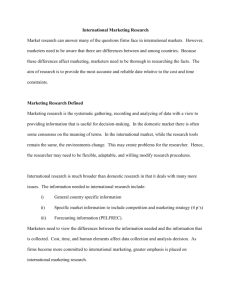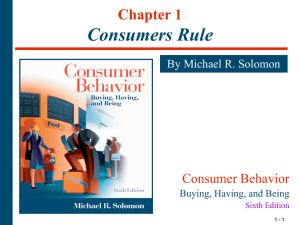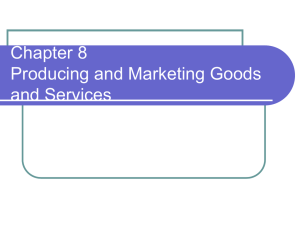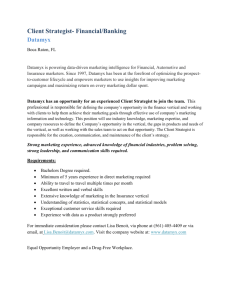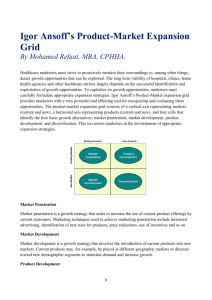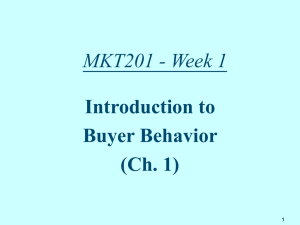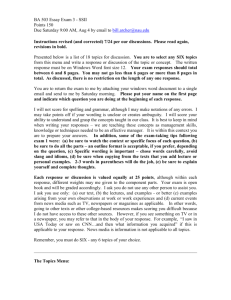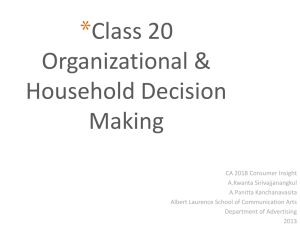WEEK 5: EFFECTIVE MARKETING DEPENDS ON
advertisement
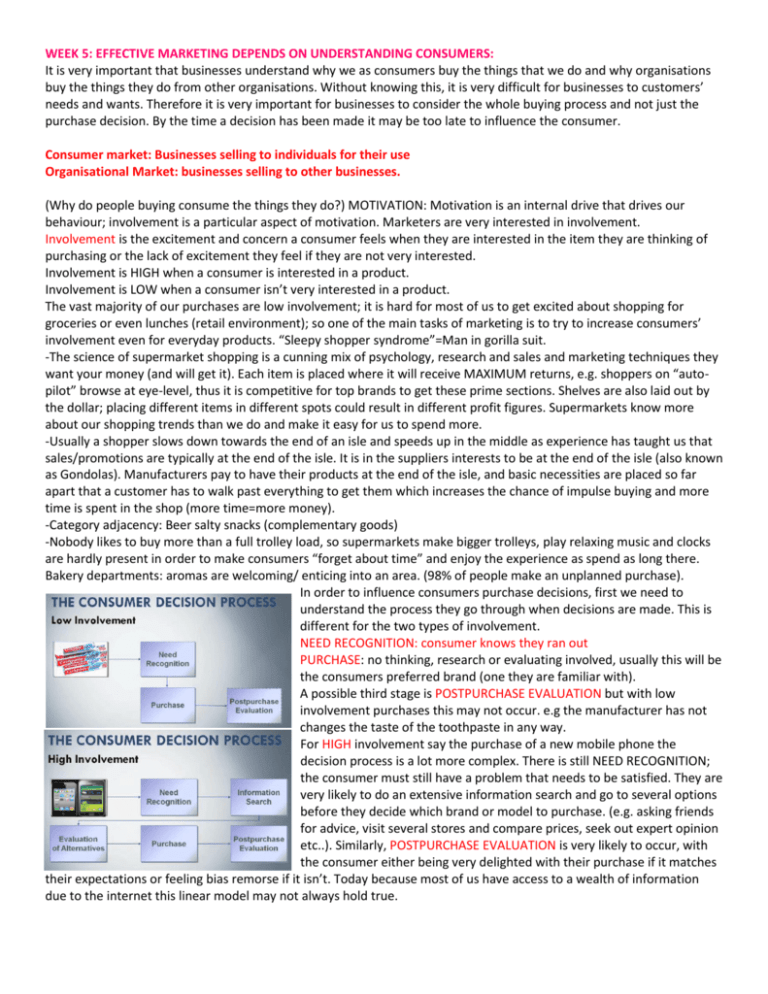
WEEK 5: EFFECTIVE MARKETING DEPENDS ON UNDERSTANDING CONSUMERS: It is very important that businesses understand why we as consumers buy the things that we do and why organisations buy the things they do from other organisations. Without knowing this, it is very difficult for businesses to customers’ needs and wants. Therefore it is very important for businesses to consider the whole buying process and not just the purchase decision. By the time a decision has been made it may be too late to influence the consumer. Consumer market: Businesses selling to individuals for their use Organisational Market: businesses selling to other businesses. (Why do people buying consume the things they do?) MOTIVATION: Motivation is an internal drive that drives our behaviour; involvement is a particular aspect of motivation. Marketers are very interested in involvement. Involvement is the excitement and concern a consumer feels when they are interested in the item they are thinking of purchasing or the lack of excitement they feel if they are not very interested. Involvement is HIGH when a consumer is interested in a product. Involvement is LOW when a consumer isn’t very interested in a product. The vast majority of our purchases are low involvement; it is hard for most of us to get excited about shopping for groceries or even lunches (retail environment); so one of the main tasks of marketing is to try to increase consumers’ involvement even for everyday products. “Sleepy shopper syndrome”=Man in gorilla suit. -The science of supermarket shopping is a cunning mix of psychology, research and sales and marketing techniques they want your money (and will get it). Each item is placed where it will receive MAXIMUM returns, e.g. shoppers on “autopilot” browse at eye-level, thus it is competitive for top brands to get these prime sections. Shelves are also laid out by the dollar; placing different items in different spots could result in different profit figures. Supermarkets know more about our shopping trends than we do and make it easy for us to spend more. -Usually a shopper slows down towards the end of an isle and speeds up in the middle as experience has taught us that sales/promotions are typically at the end of the isle. It is in the suppliers interests to be at the end of the isle (also known as Gondolas). Manufacturers pay to have their products at the end of the isle, and basic necessities are placed so far apart that a customer has to walk past everything to get them which increases the chance of impulse buying and more time is spent in the shop (more time=more money). -Category adjacency: Beer salty snacks (complementary goods) -Nobody likes to buy more than a full trolley load, so supermarkets make bigger trolleys, play relaxing music and clocks are hardly present in order to make consumers “forget about time” and enjoy the experience as spend as long there. Bakery departments: aromas are welcoming/ enticing into an area. (98% of people make an unplanned purchase). In order to influence consumers purchase decisions, first we need to understand the process they go through when decisions are made. This is different for the two types of involvement. NEED RECOGNITION: consumer knows they ran out PURCHASE: no thinking, research or evaluating involved, usually this will be the consumers preferred brand (one they are familiar with). A possible third stage is POSTPURCHASE EVALUATION but with low involvement purchases this may not occur. e.g the manufacturer has not changes the taste of the toothpaste in any way. For HIGH involvement say the purchase of a new mobile phone the decision process is a lot more complex. There is still NEED RECOGNITION; the consumer must still have a problem that needs to be satisfied. They are very likely to do an extensive information search and go to several options before they decide which brand or model to purchase. (e.g. asking friends for advice, visit several stores and compare prices, seek out expert opinion etc..). Similarly, POSTPURCHASE EVALUATION is very likely to occur, with the consumer either being very delighted with their purchase if it matches their expectations or feeling bias remorse if it isn’t. Today because most of us have access to a wealth of information due to the internet this linear model may not always hold true. Global management consultancy firm MCKINSEY has a new model: Started from an observation that the way in which consumers were researching and buying products was changing dramatically. The things that were driving this change, were new technologies and media vehiclesthe internet being the most important of those and also an increase in consumer empowerment, that consumers rather than sitting passively an having advertising come at them, were much more actively reaching out to their friends and family, to the internet, to blog sites to understand their options, based on this it was felt there was a real need to step back and revaluate both how consumers were going through their decision making process and what therefore companies need to concentrate on in order to make their marketing effort more productive. For many years now, the common language of marketing has been what people have been the “PURCHASE FUNNEL” (wide at the front, narrow at the back) in other words people became aware of the brand, it went into something they would consider, and then it turned into purchasing and then loyalty. However, this doesn’t actually describe how people go through the decision making process, additionally qualitative research has shown that these steps are not so linear (do not have to be followed chronologically) it was a circular process. CONSUMER DECISION JOURNEY: -It begins with ONGOING EXPOSURE, people see and hear about brands. Awareness Familiarity Consideration Purchase Loyalty -A TRIGGER OF SOME SORT occurs when people start towards the purchasing pahse. -While purchasing the first stage is initial consideration. Many people start this phase with a very narrow list due to busy lives and the bombardment of media which makes it very difficult for industries to get through this clutter in the intial consideration pahse. However, once the consumer decids they are going to buy they move into a stage called “active evaluation”. It is here that the number of brands they are considering increases (THIS IS THE OPPOSITE OF THE FUNNEL GOING FROM BROAD TO NARROW). This is the stage when the consumer is intent on purchasing and they are actively researching the product and the options they have for purchase e.g going on the internet, really paying attention to advertising on t.v that they weren’t before as they were not in active evaluation. The third stage is CLOSURE: this is the moment of purchase, for many products that sell in a retail environment this is a critical moment. Many consumers as they come into the store, still have not decided which brand they want to purchase. They make that decision in the store. The final stage is the loyalty loop, difference=active and passive loyalists. ACTIVE LOYALTY is the traditional view, where people don’t really consider other brands when re purchasing. PASSIVE LOYALTY is when people are open to repurchasing but are equally if not more compelled to consider other brands when it comes to the active evaluation phase. The most important thing for marketers to do is to make sure their marketing activities are alligned with how their consumer should research and buy products. BUSINESS TO BUSINESS OR ORGANISATIONAL DECISION MAKING IS IMPORTANT: Not all purchases are made by consumers. Generally speaking the organisational decision process is easier to understand: -As it is clearly driven by economics not emotion. -Formal buying process-no impulse purchasing -Needs of majority are important -A number of pople involved in purchase -Extablished relationships between buyers and sellers. MARKETERS NEED TO UNDERSTAND THEIR CONSUMERS (they like to be very close to their consumers): what ‘problems’ potential buyers have (what causes these problems?). Marketers develop programmes and introduce products that solve consumers’ problems. Consumers don’t know they have a problem until marketers tell them they do changing words, showing things in a different way. INVESTIGATING CONSUMER PROBLEMS (understand their needs and wants): By utilising MARKETING RESEARCH: QUANTITATIVE TECHNIQUES: -Surveys: on consumer satisfaction -Experiments: Which flabour do you prefer? QUALITATIVE TECHNIQUES: (more in depth) -Interview: have a conversation and get a better understanding of their emotions -Focus groups: If marketers are looking to increase consumers nvolvement, a good way to do so is to increase their emotional response to a product. MARKETING STRATEGIES: marketers are in the business of satisfying wants and needs and activage problem recognition; but what if: -I need if but I don’t want it? -dentist -I want if but i don’t need it? –chocolate Sometimes the wants and needs are concrete-based on rational, logical thinking e.g replace the old car. Sometimes they are simpply emotional e.g. shoes to feel better about life. THE JOB OF THE MARKETER IS TO PERSUADE CONSUMERS THAT A PARTICULAR CONSUMERS THAT A PARTICULAR PRODUCT WILL SOLVE THEIR PROBLEMS. Shopping gives us a natural high; marketers want to connect to the consumer. FATEFUL PURPOSES: The failure is at the top. The executives responsible for it, in the last analysis, are those who deal with broad aims and policies. Today, TV is a bigger business than the old narrowly defined movie business ever was. Had Hollywood been customer oriented (providing entertainment) rather than product oriented (making movies), would it have gone through the fiscal purgatory that it did? What ultimately saved Hollywood and accounted for its resurgence was the wave of new young writers, producers, and directors whose previous successes in television had decimated the old movie companies and toppled the big movie moguls. There are other, less obvious examples of industries that have been and are now endangering their futures by improperly defining their purposes ERROR OF ANALYSIS: [What is lacking is] the will of the companies to survive and to satisfy the public by inventiveness and skill."' Shadow of Obsolescence”; it is impossible to mention a single major industry that did not at one time qualify for the magic appellation of "growth industry." In each case, the industry's assumed strength lay in the apparently unchallenged superiority of its product. There appeared to be no effective substitute for it. It was itself a runaway substitute for the product it so triumphantly replaced. Yet one after another of these celebrated industries has come under a shadow. GROCERY STORES Many people find it hard to realize that there ever was a thriving establishment known as the "corner store." The supermarket took over with a powerful effectiveness. Yet the big food chains of the 1930s narrowly escaped being completely wiped out by the aggressive expansion of independent supermarkets A SELF-DECEIVING CYCLE: There are four conditions that usually guarantee this cycle: 1. The belief that growth is assured by an expanding and more affluent population; 2. The belief that there is no competitive substitute for the industry's major product; 3. Too much faith in mass production and in the advantages of rapidly declining unit costs as output rises; 4. Preoccupation with a product that lends itself to carefully controlled scientific experimentation, improvement, and manufacturing cost reduction POPULATION MYTH: The belief that profits are assured by an expanding and more affluent population is dear to the heart of every industry. It takes the edge off the apprehensions everybody understandably feels about the future. If consumers are multiplying and also buying more of your product or service, you can face the future with considerably more comfort than if the market were shrinking. An expanding market keeps the manufacturer from having to think very hard or imaginatively. Although there is widespread unawareness of this fact, it is conceivable that in time, the oil industry may find itself in much the same position of retrospective glory that the railroads are now in. One of the characteristics of this and other industries that have believed very strongly in the beneficial consequences of an expanding population, while at the same time having a generic product for which there has appeared to be no competitive substitute, is that the individual companies have sought to outdo their competitors by improving on what they are already doing. ASKING FOR TROUBLE: In other words, the petroleum industry's efforts have focused on improving the efficiency of getting and making its product, not really on improving the generic product or its marketing. Moreover, its chief product has continually been defined in the narrowest possible terms - namely, gasoline, not energy, fuel, or transportation. This attitude has helped assure that: • Major improvements in gasoline quality tend not to originate in the oil industry. The development of superior alternative fuels also comes from outside the oil industry, as will be shown later. • Major innovations in automobile fuel marketing come from small, new oil companies that are not primarily preoccupied with production or refining. These are the companies that have been responsible for the rapidly expanding multi pump gasoline stations, with their successful emphasis on large and clean layouts, rapid and efficient driveway service, and quality gasoline at low prices. PRODUCTION PRESSURES: Mass production industries are impelled by a great drive to produce all they can. The prospect of steeply declining unit costs as output rises is more than most companies can usually resist. The profit possibilities look spectacular. All effort focuses on production. The result is that marketing gets neglected PRODUCT PROVINCIALISM: The tantalizing profit possibilities of low unit production costs may be the most seriously self-deceiving attitude that can affect a company, particularly a "growth" company, where an apparently assured expansion of demand already tends to undermine a proper concern for the importance of marketing and the customer. The usual result of this narrow preoccupation with so-called concrete matters is that instead of growing, the industry declines. It usually means that the product fails to adapt to the constantly changing patterns of consumer needs and tastes, to new and modified marketing institutions and practices, or to product developments in competing or complementary industries. The classic example of this is the buggy whip industry. No amount of product improvement could stave off its death sentence. But had the industry defined itself as being in the transportation business rather than in the buggy whip business, it might have survived. It would have done what survival always entails - that is, change. Even if it had only defined its business as providing a 5timulant or catalyst to an energy source, it might have survived by becoming a manufacturer of, say, fan belts or air cleaners. The marketing effort is still viewed as a necessary consequence of the product-not vice versa, as it should be. CREATIVE DESTRUCTION: It is not surprising that, having created a successful company by making a superior product, management continues to be oriented toward the product rather than the people who consume it. DANGERS OF R&D: Another big danger to a firm's continued growth arises when top management is wholly transfixed by the profit possibilities of technical research and development. To illustrate, I shall turn first to a new industryelectronics-and then return once more to the oil companies. By comparing a fresh example with a familiar one, I hope to emphasize the prevalence and insidiousness of a hazardous way of thinking. MARKETING SHORT CHANGED: In the case of electronics, the greatest danger that faces the glamorous new companies in this field is not that they do not pay enough attention to research and development but that they pay too much attention to it. And the fact that the fastestgrowing electronics firms owe their eminence to their heavy emphasis on technical research is completely beside the point. THE VISCERAL FEEL OF GREATNESS: Obviously, the company has to do what survival demands. It has to adapt to the requirements of the market, and it has to do it sooner rather than later. But mere survival is a so-so aspiration. Anybody can survive in some way or other, even the skid row bum. The trick is to survive gallantly, to feel the surging impulse of commercial mastery: not just to experience the sweet smell of success but to have the visceral feel of entrepreneurial greatness. No organization can achieve greatness without a vigorous leader who is driven onward by a pulsating will to succeed. A leader has to have a vision of grandeur, a vision that can produce eager followers in vast numbers. In business, the followers are the customers. In order to produce these customers, the entire corporation must be viewed as a customer-creating and customer satisfying organism. Management must think of itself not as producing products but as providing customer-creating value satisfactions. It must push this idea (and everything it means and requires) Into every nook and cranny of the organization. It has to do this continuously and with the kind of fiair that excites and stimulates the people in it. Otherwise, the company will be merely a series of pigeon holed parts, with no consolidating sense of purpose or direction. In short, the organization must learn to think of itself not as producing goods or services but as buying customers, as doing the things that will make people want to do business with it. And the chief executive has the inescapable responsibility for creating this environment, this viewpoint, this attitude, this aspiration. The chief executive must set the company's style, its direction, and its goals. This means knowing precisely where he or she wants to go and making sure the whole organization is enthusiastically aware of where that is. This is a first requisite of leadership, for unless a leader knows where he is going, any road will take him there. FOUR ERAS IN THE HISTORY OF MARKETING: EXCHANGE PROCESS: Activity in which two or more parties give something of value to each other to satisfy perceived. PRODUCTION: This production orientation dominated business philosophy for decades: business success was defined solely in terms of production success. -Companies with a SALES orientation assume that customers will resist purchasing nonessential goods and services and that the task of personal selling and advertising is to persuade them to buy. -CONSUMER ORIENTATION: Business philosophy incorporating the marketing concept that emphasises first determining unmet consumer needs and then designing a system for satisfying them. MARKETING CONCEPT: Companywide consumer orientation with the objective of achieving longrun success -RELATIONSHIP marketing involved developing long-term, value added relationships over time with customers and suppliers. Strategic alliances and partnerships among manufacturers, retailers and suppliers and benefit everyone (mutual benefit). Marketing is the process of creating value for customers and building relationships with those customers in order to capture value back from them. Marketing requires research and analysis, strategic planning and persuasive communication. It also focuses on non-profit organisations; politician and celebrities constantly market themselves. PLACE MARKETING: Marketing efforts to attract people and organisations to a particular GEOGRAPHICAL AREA. CAUSE-RELATED MARKETING: Identification and marketing of a social issue, cause, or idea to selected target markets. NEEDS: Differences between a person’s actual sate and his or her ideal state; they provide the basic motivation to make a purchase. WANTS: Specific goods, services, experiences, or other entities that are desirable in light of a person’s experiences, culture and personality. EXCHANGE PROCESS: The act of obtaining a desired object or service from another party by offering something of value in return. TRANSACTION: An exchange of value between parties. MARKETING CONCEPT: An approach to business management that stresses customer needs and wants, seeks long term profitability, and integrates marketing with other functional units within the organisation. THE FOUR UTILITIES: To encourage the exchange process, marketers enhance the appeal of their g/s by adding utility (the power of a good or service to satisfy a human need). When organisations change raw materials into finished goods, they are creating form utility desired by consumers. When supermarkets provide fresh, ready to eat dishes as an alternative to food ingredients, they are creating form utility. In other cases, marketers try to make their products available when and where customers want to buy them, creating time utility and place utility. Overnight couriers such as FedEx create time utility, whereas coffee carts in office buildings and ATMs in shopping malls create place utility. Services such as Apple’s iTunes create both time and place utility. Purchasing music is instant without leaving an internet connected area. The final form of utility is possession utility- satisfaction that that buyers get when they actually possess a product, both legally and physically. Mortgage companies, for example, create possession utility of offering loans that allow people to buy homes they could otherwise not afford. RELATIONSHIP MARKETING: A focus on developing and maintaining long-term relationships with customers, suppliers, and distribution partners for mutual benefit. CUSTOMER LOYALTY: The degree to which customers continue to buy from a particular retailer or buy the products of a particular manufacturer or service provider. CUSTOMER RELATIONSHIP MANAGEMENT (CRM): A type of information system that MARKET captures, organises, and capitalises on all the interactions that a company has with its customers. SOCIAL COMMERCE: The creation and sharing or product related information PROFITS THROUGH among customers and potential customers. CUSTOMER NEEDS CUSTOMER SATISFACTION MARKETING RESEARCH: The collection an analysis of information for marketing decisions. PERMISSION-BASED MARKETING: A marketing approach in which firms ask permission CONVERSATIONAL to deliver messages to an audience and then promise to restrict their communication COMMUNICATION efforts to those subject areas in which audience members have expressed interest. STEALTH MARKETING: the delivery of marketing messages to people who are not aware that they are being marketed to; these messages can be delivered by either acquaintances or strangers, defending on the technique. Three general issues that many marketing organisations are wrestling with today are involving the customer in the marketing process, making data driven decisions, and conducting marketing with greater concerns for ethics and etiquette. Allowing customers greater involvement is essential to relationship making and the marketing concept. Increasingly, this involvement is enabled by social commerce-customers using social media to converse with companies and each other. Data driven decision making is a top priority as many companies struggle to justify and optimise marketing expenditures. Public opinion of business in general and marketing in particular is at a low point these days, prompting many professionals to take a closer look and their business practices and relationships with customers.


